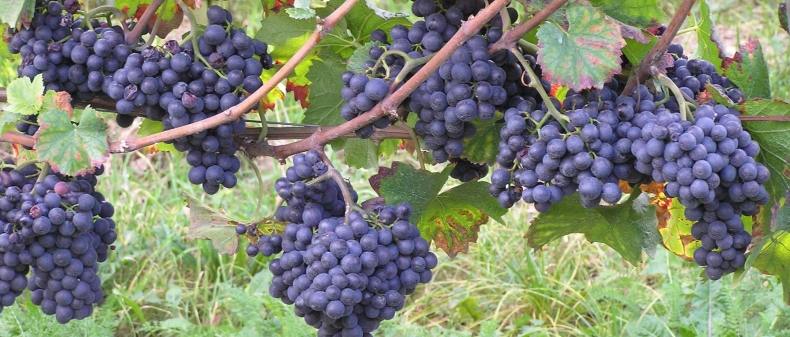
Image: edenwines.co.uk
I can think of worse ruts to be in than regular consumption of pinot noir, one of the world’s prettiest and most expressive red varieties. It’s grown widely, wherever it’s cool enough to allow the grape to express its refined and elegant side, and many places that are frankly too warm, too. There’s plenty of speculation about the grape’s origins (I’ve heard central Europe in the Carpathian Basin, but that’s unconfirmed), but what is known is that it’s one of the world’s most ancient varieties that has parented dozens of other grapes, and it’s spiritual homeland is the Côte d’Or in Burgundy. Pinot noir is prone to mutation, most notably into blanc and gris/grigio shades, and is commercially available in an incredible variety of clones that can dramatically affect wine style. If you want to sound cool when talking to a pinot noir maker, ask him or her what clones they’ve planted, and then give a knowing nod as they list off numbers (meaningless to most of us) like 667, 777 and 119.
Pinot Noir is colour-challenged, rarely more a pale-medium garnet, so if you love it, then you’re luckily not a slave to deep-coloured reds. Its structure is based more on acidity than tannins, which are usually fine-grained and silky, yet it’s surprisingly age-worthy from the top sites. The grape is notoriously finicky and both hard to grow and vinify well; the best are hauntingly beautiful wines, the worst are pricey disappointments. Being sensitive to over-cropping (allowing too much fruit to grow on each vine) means that good pinot is always expensive to make. But there are other ways to deal with your pinot-envy.
If you’re partial to delicate, complex wines that are expressive of their origins, then you’ll also like:
- Nerello mascalese
- Frappato
- Nebbiolo
- Xinomavro
- Trousseau
- Kadarka
Nerello Mascalese is a Sicilian variety with a reputed genetic relation to Sangiovese. It’s the principal grape in Etna Rosso DOC, where it’s frequently blended with nerello cappuccio. Like pinot noir, nerello (from Italian nero, meaning ‘little’ or ‘slightly’ black in colour) produces deceptively pale wines with intense structure based on acid and moderate tannins. When grown on the cool, volcanic upper slopes of Mount Etna, mascalese produces wines of incredible salty-minerality and beguiling wild strawberry perfume. The growing number of quality-oriented producers, starting with Benanti in the late 1980s, is good news for us. Old vine, single parcel wines are increasingly common.
Frappato is another predominantly Sicilian variety, most famously used the region’s only DOCG-designated wine, Cerasuolo di Vittoria, where it’s blended with Nero d’Avola, though varietal wines are also found. It’s pale in colour, delicate in structure and exotically perfumed. If you can track down the Frappato of the lovely Ariana Occhipinti, be forewarned that you might just fall irremediably in love.
Nebbiolo is the king of Piemontese red grapes, increasingly planted around the world in places like California, Australia, and even Niagara. If you’re a pinot fan, than you’ll likely have already discovered the brilliant wines of Barolo, Barbaresco and the Valtellina in neighboring northern Lombardy, as these are the spiritual cousins of great red Burgundy. Don’t be fooled by the deceptive pale garnet colour; nebbiolo is one of the world’s most structured and age worthy grapes. It has considerably more tannin than pinot noir, which is why it’s often aged for several years before release. Barolo Riserva, for example, is released after a minimum of five years ageing by law in the producer’s cellar. Nebbiolo, like pinot, has an uncanny ability to reflect the vineyard in which it originates, and vineyard-designated wines are common. If you prefer the silkier style, opt for Barbaresco and Valtellina, or wines from the west side of the Barolo appellation from vineyards around villages like La Morra and Barolo itself. A little homework is required to learn which vineyards are located in this half of the appellation.
Xinomavro is an ancient Greek variety used most famously in the Macedonian appellations of Naoussa and Amydeon. It resembles nebbiolo in style and structure, or, as well-known Greek sommelier Yiannis Kaimenakis once described it to me, like pinot noir in blue jeans. It’s pale, well-endowed with acidity and tannins, and incredibly perfumed with plenty of earth, olive, sundried tomato, savoury herb and red berry fruit aromas. It too, is highly site sensitive and reflective of its origins.
Trousseau is the principal red grape of the oft-overlooked wines of the Jura in eastern France, across the Saône River Valley from Burgundy. It also grows in central Portugal under the name Bastardo, and is a component of traditional port wine blends. I’ve even come across it as a varietal wine in California, made by the cutting edge producer Arnot-Roberts. Light-bodied, firm and cherry/pomegranate-scented, trousseau is a pinot noir lover’s delight, definitely not for size freaks. I’d say the world categorically needs more trousseau.
Kadarka was once the most planted red variety in Hungary, though due to its low yields and propensity to rot in unsuitably humid areas, it was largely abandoned in the post WWII era dedicated to quantity over quality. It’s slowly being re-discovered, and multiple trials are underway to find the most suitable clones for regions like Eger and Szekszárd. It can almost look more like rosé than red, and has a wild perfume reminiscent of paprika-dusted red berry fruit. Light tannins and moderate acidity are the norm.
_____
John Szabo is a master sommelier and wine writer for Toronto Standard. Follow his tweets here: @johnszabo.
More recommendations by John Szabo at www.johnswines.com
For more, follow us on Twitter @TorontoStandard and subscribe to our newsletter.














